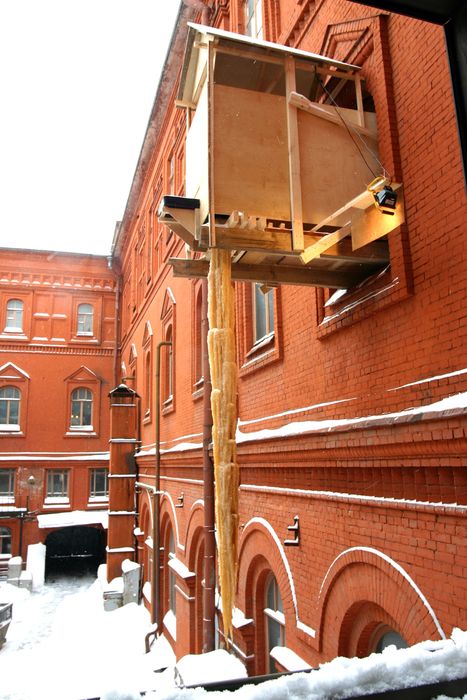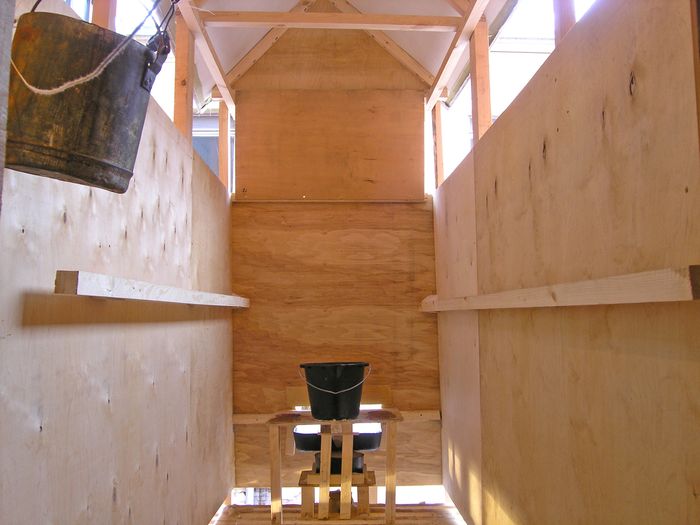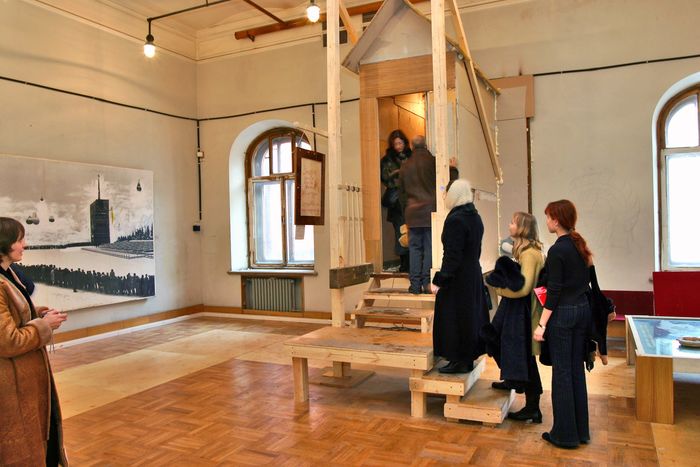While researching for an inspiring example of interactive art, I discovered a few artists who make quite a lot of interactive art pieces. Thus, I will be sharing a few works by each artists because I find them too interesting not to share!!
RAFAEL LOZANO-HEMMER
Rafael Lozano-Hemmer was born 1967 in Mexico. His work can be considered a blend of interactive art and performance art, using both large and small scales, indoor and outdoor settings, and a wide variety of audiovisual technologies. Lozano-Hemmer is best known for creating and presenting theatrical interactive installations in public spaces across Europe, Asia and America. Using robotics, real-time computer graphics, film projections, positional sound, internet links, cell phone interfaces, video and ultrasonic sensors, LED screens and other devices, his installations seek to interrupt the increasingly homogenized urban condition by providing critical platforms for participation. His smaller-scaled sculptural and video installations explore themes of perception, deception and surveillance.
Under Scan is an interactive video art installation for public space. Passers-by are detected by a computerized tracking system, which activates video-portraits projected. The portraits projected were recordings of volunteers who were free to portray themselves in whatever way they desired. These portraits are projected at random positions. When the viewer covers the projections with their shadow, the portraits are “revealed” and thus “wake-up” and establish eye contact with the viewer. As the viewer walks away, the portrait reacts by looking away, and eventually disappears if no one activates it.
Every 7 minutes the entire project stops and resets. The tracking system is revealed in a brief “interlude” lighting sequence, which projects all of the calibration grids used by the computerized surveillance system. Under Scan was inspired by
The piece was inspired by mise en abyme in visual works such as Jan Van Eyck’s paintings, where the portrayed (who is also the viewer) makes eye-contact with the viewer. Other inspirations for this work include the post-photographic device described in La invención de Morel, written by Adolfo Bioy Casares (1940). In the novel, a character called Morel tells the tourists he has been recording their actions of the past week with a machine he invented that is capable of reproducing reality. The recording capture their souls, and enables them to relive that week forever through relooping the recording. As such, the recording is able to overlap with reality.
My thoughts: I found the concept of using peoples shadows as an input to trigger an output really interesting. I am also amazed at how their shadows makes the projections clearer, instead of obscuring them completely. Additionally,I think that the small details like how when the viewer walks away, the portrait looks away, and "sleeps" if there is no input anymore. I find the whole trigger and deactivating system well thought about. I can also see how the artwork relates to Morel's photographic device- The portrait projections and viewers shadows parallels (in the novel,)the recording overlapping with reality.
Sandbox is a large-scale interactive installation. On two small sandboxes tiny projections of people appear. These projections are actually real time projections of people on the two larger sandboxes (a.k.a the beach). As participants reach out to touch the small projection of people , a camera detects their hands and relays them live to two of the world’s brightest projectors, which hang from a boom lift. Their hands are live-streamed and projected over the beach. In this way people share three scales: the tiny sandbox images, the real human scale and the gigantic scale of special effects. These images are amplified by digital cinema projectors which create an animated topology over the beach, make tangible the power asymmetry inherent in technologies of amplification.
I really love how simple, and yet complicated this project is. It is amazing to see how participants are able to interact with each other indirectly and yet directly, through the clever manipulation of scale. The use of live-streaming and real time feedback is a very immersive way to get participants to play with each other through the artwork. Perhaps something we can think about! This work amplifies human connection, and I think it is a very successful interactive media artwork as it is v engaging. Lozano-Hammer's use of projections as a medium, although tricky, is also something I think we can consider using. I find the technical execution of this work really impressive, as it looks rather seamless and considering this was made back in 2010!
RAFAEL LOZANO-HEMMER has a lot of really cool works, you can check them out!! : - Pulse (2019) - Cloud Display (2019) - Pareidolium (2018) - http://www.lozano-hemmer.com/projects.php
JEPPE HEIN
Jeppe Hein was born in 1974, and is an artist based in Berlin and Copenhagen. His interactive sculptures and installations combine elements of humour with the 1970s traditions of minimalism and conceptual art.
Path of Frequencies is a site-specific installation of steel tracks that responds to the architectural configuration of the museum, assembled to run through the entire exhibition space like a guided path. As each visitor enters the space, a sensor is activated and releases a ball on a string. The ball is then set in motion along a dynamic and meandering track, creating various tones as it collides with singing bowls dispersed throughout the space. Visitors are accompanied by a unique and continuous sound during their visit, experienced physically in the vibrations that the singing bowls produce. In addition, the emerging melody becomes a connecting element between visitors as they unconsciously make music together.
I personally like how this artwork is both an individual and a collective experience. Each visitor experiences the same path that the ball is set on, yet depending on other fellow visitors, the collective sound this work generates in the end is different. I also enjoy how input is the viewers presence, while output is the motion of the ball; and that the motion of the ball creates an additional audio output for the viewers.
A large mirror hangs on the wall with a small bench positioned in front of it. Upon taking a seat on the bench, visitors begin to observe their own reflections. However, a small trigger activates a fog machine within the bench, releasing smoke from small holes that surround the seat. Thus while contemplating their reflections in the mirror, they see themselves engulfed in a cloud of smoke, gradually reappearing only as the fog dissipates.
I like the idea of how you can see yourself go through the process of the artwork, but not through a digital medium such as live-stream or recording. Instead a mirror is used for the viewer to see their own reflection and to witness what is happening to them as they are engulfed. Being able to see yourself through the mirror provides a sort of out of body experience due to seeing your entire self through someone else's pov (instead of first person); And I feel that this enhances the ephemeral and other-wordly experience that the fog also comes with. The visuals of the fog coming out through small holes in the chair due to the viewer's pressure (upon sitting) is definitely eye catching, and pretty engaging.
At first sight, with their black leather and white-painted wood, Jeppe Hein’s benches seem to be a permanent fixture in the museum’s décor. Looking like any average bench in a museum institution, each bench is positioned parallel to the architectural form of the space. However, this benches are also motorized. The moment visitors sit on them, the benches unexpectedly move. The benches reposition the seated visitor by moving a calculated distance when activated by the weight of the body. By adding this surprising element Jeppe Hein creates food for discussion and puts a smile on people’s lips. At the same time, he draws attention to the bench and its function.
Although the execution of this work is rather straight forward, it is not only fun, but also quite meaningful. Thebench is a common item in a museum, but this time, it has become the artwork itself. However, if no one were to sit on the bench, then it does not function as how it was intended to as an artwork. So then, if there is no human input, the bench is still just a bench right? But once there is human input (weight via pressure sensors), the bench comes to live and moves- becoming the statement piece of art it was programmed to be. It is interesting that the work only comes into its own right, when visitors use it. It is also interesting that the artwork in focus is now a bench, instead of the artwork that the bench was placed in front of. This is a simple interactive work of art yet worthy of discussions, which I think is something our works should strive for too!
JEPPE HEIN has other interesting works, you can check: - Appearing Rooms (2004) - Self Destructing Wall (2003) - Let Me Show You The World (2000) - Bear Your Consequences (2018) - Today I Feel Like (2018) - https://www.jeppehein.net/pages/works.php
GELITIN
Gelitin is a group of four artists from Vienna, Austria. The group consists of Wolfgang Gantner, Florian Reither, Ali Janka and Tobias Urban. They were formerly known as Gelatin and changed their name in 2005. They are known for creating sensational art events in the tradition of Relational Aesthetics, often with a lively sense of humor, and the occasional nudity involved.

In the Moscow Lenin Museum, a hanging hut outside was mainly built to keep the cold temperatures outside the museum halls and to offer some privacy. However, Gelitin did a cheeky move and turned it into an outdoor loo where people could “support(ed) Gelatin by donating a watery solution of metabolic wastes (such as urea), dissolved salts and organic materials”. This waste would then be poured down a chute in the hut. In the cold temperatures of russian winter, the hot piss was frozen really quickly and formed an ice sculpture. In the end, this collective ice sculpture was made with the help of “some 200 thousand kidneys” (aka. museum goers who volunteered to play a part in this artwork). The iceicle eventually ” turned into a handsome 7 meter tall and one meter fat pipi amber colored iceicle” after some weeks.
This interactive artwork is amazing because it is cheeky and really funny. It is kind of provocative? Some people might call it a piss-poor work of art: how is frozen pee art?? Its hilarious. I think that this is a really unique artwork that invites participants to come and do something really weird together. And evidently, the appeal of this project was really strong... so many volunteers, with such a tall and fat icicle as a final product... It works well as an engaging work of interactive art! Obviously, in a school setting, I doubt we can use such controversial materials, but this work can inspire us to start thinking out of the box when we are considering what mediums to use; or how/what every participant is able to contribute to the interactive artwork.
A wooden and metal structure was built for Parallel Vienna 2016. With the help of 30 strong men, participants were provided the experience of riding a human elevator. Participants were manually lifted several floors up by the men
Like Zapf de Pipi, I find that this work is a good example of interactive works that are non-digital. There is no technological element at all in both these works, yet they are able to provide a very interactive experience for the participant. Human Elevator is a performance artwork that makes use of volunteers in the process to create not only a performative process, but also a personal experience for other participants. It has definitely inspired me to think of how I can perhaps aim to create a work whereby, the whole process and end result is heavily dependent on the actions of those who participate/ volunteer, and to create a work that is more playful/fun
GELITIN has a lot of really weird and funny works, I implore you to check them out!! : - Ritratto Analitico (2013) - Klunk Garden (2009) - Gedichte von einem Freund (2014) - Normally, Proceeding and Unrestricted With Without Title(2008) - Die Tusovka Runde (2014) - Gelatin at the Shore of Lake Pipi Kacka (2003) - https://www.gelitin.net/projects



https://schizophonia.com/portfolio/dislocation/